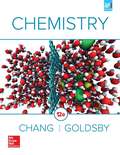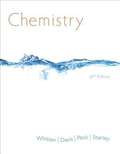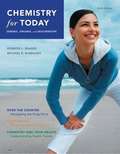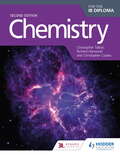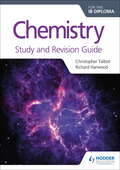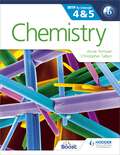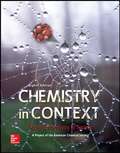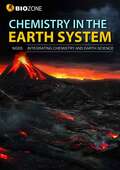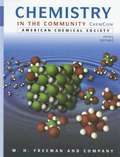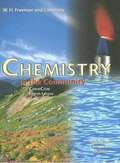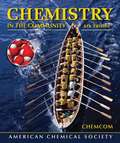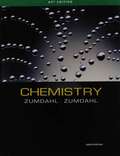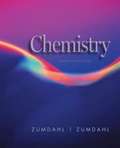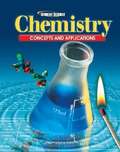- Table View
- List View
Chemistry (Ap Chemistry Chang Ser.)
by Raymond Chang Kenneth GoldsbyChang's best-selling general chemistry textbook takes a traditional approach and is often considered a student and teacher favorite. The book features a straightforward, clear writing style and proven problem-solving strategies. It continues the tradition of providing a firm foundation in chemical concepts and principles while presenting a broad range of topics in a clear, concise manner. The tradition of "Chemistry" has a new addition with co-author, Kenneth Goldsby from Florida State University, adding variations to the 12th edition. The organization of the chapter order has changed with nuclear chemistry moving up in the chapter order.
Chemistry Hybrid 10th Edition
by Raymond E. Davis M. Larry Peck George G. Stanley Kenneth W. WhittonHigh School chemistry textbook.
Chemistry for Christian Schools
by Thomas E. Porch Heather E. Cox John S. WetzelChemistry for Christian Schools- in addition to having problems in abundance for student practice, also talks about the history of chemistry and about many ways that Christianity and chemistry are related.
Chemistry for Today: General, Organic, and Biochemistry
by Spencer L. Seager Michael R. SlabaughYou will quickly gain a comprehensive understanding of chemistry with this new Sixth Edition of CHEMISTRY FOR TODAY: GENERAL, ORGANIC, AND BIOCHEMISTRY. Using real-life applications and interactive technology tools, this text will show you how chemistry relates to health science. The thorough integration of online assessment and learning tools turns study time into experiences with chemistry--helping you gain true comprehension of chemical concepts. CHEMISTRY FOR TODAY will help dispel any fear you may have of chemistry as it helps you appreciate the role chemistry plays in our daily lives through a rich pedagogical structure and an accessible writing style with lucid explanations. In addition, Seager and Slabaugh's CHEMISTRY FOR TODAY provides greater support in both the problem-solving and critical-thinking skills needed to succeed in chemistry. By illustrating how this information will help your future career and providing important career information online, the authors help you set goals and focus on achieving them.
Chemistry for the IB Diploma Second Edition
by Christopher Coates Christopher Talbot Richard HarwoodProvide clear guidance to the 2014 changes and ensure in-depth study with accessible content, directly mapped to the new syllabus and approach to learningThis second edition of the highly-regarded first edition contains all SL and HL content, which is clearly identified throughout. Options are available free online, along with appendices and data and statistics.- Improve exam performance, with exam-style questions, including from past papers- Integrate Theory of Knowledge into your lessons and provide opportunities for cross-curriculum study- Stretch more able students with extension activities- The shift to concept-based approach to learning , Nature of Science, is covered by providing a framework for the course with points for discussion - Key skills and experiments included - Full digital package - offered in a variety of formats so that you can deliver the course just how you like!
Chemistry for the IB Diploma Study and Revision Guide
by Christopher Talbot Richard HarwoodStretch your students to achieve their best grade with these year round course companions; providing clear and concise explanations of all syllabus requirements and topics, and practice questions to support and strengthen learning. - Consolidate revision and support learning with a range of exam practice questions and concise and accessible revision notes- Practise exam technique with tips and trusted guidance from examiners on how to tackle questions- Focus revision with key terms and definitions listed for each topic/sub topic
Chemistry for the IB MYP 4 & 5: By Concept (MYP By Concept)
by Christopher Talbot Annie TermaatThe only series for MYP 4 and 5 developed in cooperation with the International Baccalaureate (IB)Develop your skills to become an inquiring learner; ensure you navigate the MYP framework with confidence using a concept-driven and assessment-focused approach presented in global contexts.- Develop conceptual understanding with key MYP concepts and related concepts at the heart of each chapter.- Learn by asking questions with a statement of inquiry in each chapter. - Prepare for every aspect of assessment using support and tasks designed by experienced educators.- Understand how to extend your learning through research projects and interdisciplinary opportunities.This title is also available in two digital formats via Dynamic Learning. Find out more by clicking on the links at the top of the page.
Chemistry in The Earth System: Integrating Chemistry and Earth Science, NGSS
by Tracey Greenwood Kent Pryor Lissa Bainbridge-SmithNIMAC-sourced textbook
Chemistry in the Community
by American Chemical Society"Chemistry in the Community is a post-secondary chemistry course structured around applied community issues related to chemistry rather than around specific chemical concepts. Concepts are presented on a ""need-to-know"" basis, allowing students to experience chemistry on first hand. The course is about 50% laboratory-based, and features activities where students must apply their chemistry knowledge to realistic decision-making situations."
Chemistry in the Community
by American Chemical Society"Chemistry in the Community is a post-secondary chemistry course structured around applied community issues related to chemistry rather than around specific chemical concepts. Concepts are presented on a ""need-to-know"" basis, allowing students to experience chemistry on first hand. The course is about 50% laboratory-based, and features activities where students must apply their chemistry knowledge to realistic decision-making situations."
Chemistry in the Community (4th Edition)
by American Chemical SocietyChemistry in the Community (ChemCom) is a year-long high school chemistry course for college-bound students, structured around community issues related to chemistry. The course is about 50% laboratory-based, and features decision-making activities which give students practice in applying their chemistry knowledge in realistic decision-making situations. Concepts are presented on a "need-to-know" basis, allowing students to experience the use and application of their chemistry learning, leading to a greater sense of motivation and a feeling of ownership of their new knowledge. Because of the nature of the issues covered in the specific units, students learn more organic and biochemistry than in traditional courses, as well as some environmental and industrial chemistry.
Chemistry in the Community: Chemcom
by American Chemistry SocietyNIMAC-sourced textbook <P><P>Touted as the most successful NSF-funded project published, Chemistry in the Community (ChemCom) by the American Chemical Society (ACS) offers a meaningful and memorable chemistry program for all levels of high school students. ChemCom covers traditional chemistry topics within the context of societal issues and real-world scenarios. Centered on decision-making activities where students are responsible for generating data in an investigating, analyzing that data and then applying their chemistry knowledge to solve the presented problem. The text is intensively laboratory-based, with all 39 of the investigations integrated within the text, not separate from the reading. With the ChemCom program, students learn more organic and biochemistry, more environmental and industrial chemistry, and more on the particulate nature of matter than other textbooks all within the relevance of solving problems that arise in everyday life. <P><P>Meticulously updated to meet the needs of today's teachers and students, the new sixth edition of ChemCom adheres to the new science framework as well as the forthcoming next generation of science standards. Incorporating advances in learning and cognitive sciences, ChemCom’s wide-ranging coverage builds upon the concepts and principles found in the National Science Education Standards. Correlations are available showing how closely aligned ChemCom is to these and other state standards
Chemistry, AP* Edition
by Steven S. Zumdahl Susan A. ZumdahlThis fully updated Ninth Edition of Steven and Susan Zumdahl's CHEMISTRY brings together the solid pedagogy, easy-to-use media, and interactive exercises that today's instructors need for their general chemistry course. Rather than focusing on rote memorization, CHEMISTRY uses a thoughtful approach built on problem-solving. For the Ninth Edition, the authors have added a new emphasis on critical systematic problem solving, new critical thinking questions, and new computer-based interactive examples to help students learn how to approach and solve chemical problems--to learn to think like chemists--so that they can apply the process of problem solving to all aspects of their lives. Students are provided with the tools to become critical thinkers: to ask questions, to apply rules and develop models, and to evaluate the outcome. In addition, Steven and Susan Zumdahl crafted ChemWork, an online program included in OWL Online Web Learning to support their approach, much as an instructor would offer support during office hours. ChemWork is just one of many study aids available with CHEMISTRY that supports the hallmarks of the textbook--a strong emphasis on models, real world applications, visual learning, and independent problem solving. Available with InfoTrac Student Collections http://gocengage. com/infotrac.
Chemistry, AP* Edition
by Steven S. Zumdahl Susan A. ZumdahlThis fully updated Ninth Edition of Steven and Susan Zumdahl's CHEMISTRY brings together the solid pedagogy, easy-to-use media, and interactive exercises that today's instructors need for their general chemistry course. Rather than focusing on rote memorization, CHEMISTRY uses a thoughtful approach built on problem-solving. For the Ninth Edition, the authors have added a new emphasis on critical systematic problem solving, new critical thinking questions, and new computer-based interactive examples to help students learn how to approach and solve chemical problems--to learn to think like chemists--so that they can apply the process of problem solving to all aspects of their lives. Students are provided with the tools to become critical thinkers: to ask questions, to apply rules and develop models, and to evaluate the outcome. In addition, Steven and Susan Zumdahl crafted ChemWork, an online program included in OWL Online Web Learning to support their approach, much as an instructor would offer support during office hours. ChemWork is just one of many study aids available with CHEMISTRY that supports the hallmarks of the textbook--a strong emphasis on models, real world applications, visual learning, and independent problem solving. Available with InfoTrac Student Collections http://gocengage. com/infotrac.
Chemistry, AP® Edition Update
by Steven S. Zumdahl Susan A. Zumdahl Donald J. DeCosteNIMAC-sourced textbook
Chemistry, Study Guide
by Paul B. KelterReflects the unique problem-solving approach of the book. Includes alternate problem solving strategies, supplemental explanations, summaries of chapter sections, 400 worked examples, 800 self-practice tests, and answers to the exercises and self-tests--all designed to help students master the text material.
Chemistry: A Contemporary Approach
by Paul S. Cohen Paul S. GeffnerThis book is designed to make learning easier for students. Its content is carefully selected and logically organized. It offers a shortened introductory chemistry course.
Chemistry: A Molecular Approach (AP Edition)
by Nivaldo J. TroA student oriented book that provides relevant information that will motivate and get them to achieve the highest possible level in chemistry.
Chemistry: Concepts And Applications
by Mcgraw-Hill StaffChemistry: Concepts and Applications is a conceptual approach to the presentation of chemistry. It has a clear and comprehensive narrative of chemistry concepts with just the right amount of math. Two of many in-text lab options include Launch Labs and Try at Home Labs, the latter of which are unique to Glencoe. The program's media/technology support diverse classroom instruction.
Chemistry: Concepts and Applications
by Cheryl Wistrom John S. Phillips Victor S. StrozakChemistry: Concepts and Applications is a conceptual approach to the presentation of chemistry. It has a clear and comprehensive narrative of chemistry concepts with just the right amount of math.
Chemistry: Concepts and Applications
by Mcgraw-Hill StaffChemistry: Concepts and Applications is a conceptual approach to the presentation of chemistry. It has a clear and comprehensive narrative of chemistry concepts with just the right amount of math. Two of many in-text lab options include Launch Labs and Try at Home Labs, the latter of which are unique to Glencoe. The program's media/technology support diverse classroom instruction.
